Advanced Laboratory Facilities
Information Systems
Campus Network

Network Operation Center
The campus network at JAIST is built with high-speed layer-3 core switches,etc. located at the Research Center for Advanced Computing Infrastructure.
In addition to the backbone switches, the floor switches also run at 10Gbps(wire speed), which enables very comfortable network access to any servers,anywhere in JAIST. The same information environment is also provided on JAIST Tokyo Satellite. Our campus network system provides 80 Gbps access to SINET5, which is the 100 Gbps full-mesh network connecting many universities, research institutes and clouds.
High-Performance Computing Systems
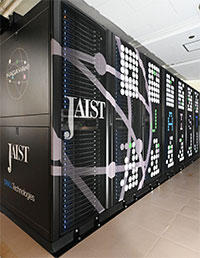
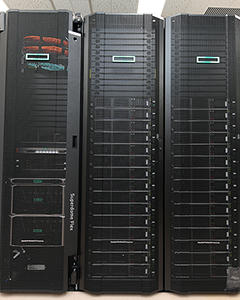
HPC system "KAGAYAKI" / HPE Superdome
A high-performance computing (HPC) system is a system consisting of server specialized for computing and fast internal connection to solve complex computational problems.HPC system "KAGAYAKI", which is the largest one in JAIST, has 280 computing nodes and total 35,840 CPU cores.All computing nodes are connected via non-blocking fat-tree topology architecture with Infiniband HDR.
High – Speed, Large –Volume Storage Systems
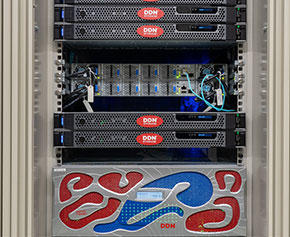
DataDirect Networks GRID Scaler
file server system
To provide a reliable file storage environment, we are running high-speed,large-capacity file server systems in parallel. Through the high-speed campus network, researchers and students can utilize the information system from any computer at JAIST without changing their individual computer environment. Data backup is provided automatically by the systems, so each user can maintain their focus on research or study. Depending on the needs of users, they can select among a variety of file servers.
Distance Learning System
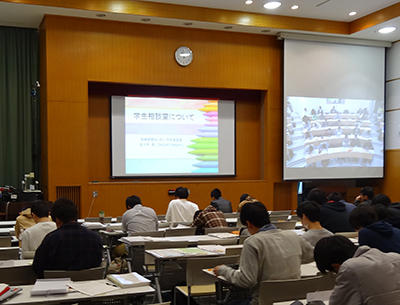
The distance learning system enables us to do lecture and conference with researchers and students at remote locations. It is a relatively small unit which includes a camera and microphones that record own side video, video/audio outputs from another side, and a codec that performs analog/digital signal conversion and transmission. Through an MCU (Multipoint Control Unit), it is possible to realize a multi-point video conference with a Full-HD video and PC screen images. We can freely use the system installed in the lecture rooms and collaboration rooms on our campus.
Equipment
| Campus Network | Juniper Networks: MX204, Cisco Systems: ASR1002 Cisco Systems: Nexus 7710, Juniper Networks: QFX10002 Palo Alto Networks: PA-5220 |
| High-Speed, Large-Volume Storage Systems | EMC Isilon Storage System DataDirect Networks GRIDScaler Storage System NetApp FAS/SolidFire Storage System |
| High-Performance Computing Systems | HPC System, "KAGAYAKI" : 280 Nodes, 35840 Cores. Superdome : 1 Node, 72 Cores/12TB memory. PC Cluster GPU Node : 8 Nodes, 16GPU(Tesla P100). PC Cluster CPU Node 1 : 30 Nodes, 1920 Cores. PC Cluster CPU Node 2 : 48 Nodes, 1536 Cores. |
| Distance Learning System | Lecture archive system: Moodle Video conference system: Polycom RealPresence PC video conference system: Cisco Webex Meetings |
| Printing Support System | RISO, Japan: ORPHIS GD9630 (High Speed Printer with Book Binding) Canon, Japan: Image PROGRAF TX-3000, ImagePROGRAF PRO-6100S (Large Format Printer) Fujitsu, Japan: Scan Snap FI-SV600 (Color Image Scanner) GBC: SureBind2000 (Portable Book Binding) |
* These are just some of the main pieces of equipment -there are many more.
Material Analysis Systems
Fourier transform ion cyclotron resonance mass spectrometer (FT-ICR MS)
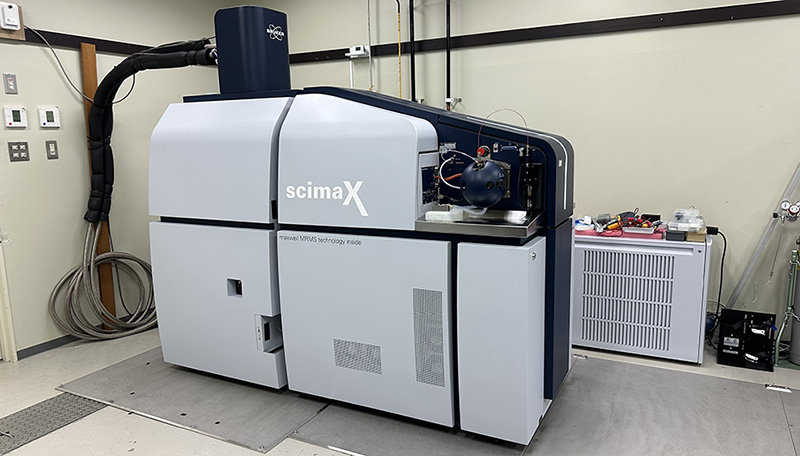
FT-ICR MS produces high-resolution mass spectrum data and further enables to determine the chemical composition of molecules. The high sensitivity of this instrument allows it to detect small amounts of components, even on the order of pico to femtomole. We can analyze a wide variety of samples, including low-molecular weight compounds, organometallic complexes, and biomolecules. It also supports MALDI imaging to visualize the localization of target molecules.
Nuclear Magnetic Resonance spectroscopy (NMR 800MHz)
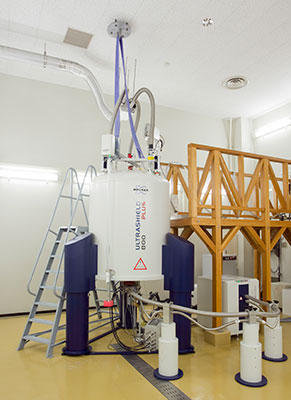
Nuclear Magnetic Resonance (NMR) spectroscopy is one of the powerful non-destructive analytical methods to obtain chemical and physical information of research samples. The high-field (800 MHz) NMR in JAIST is mainly used to investigate structure, dynamics, and interaction of biomolecules such as proteins, saccharides, DNA and RNA.
Scanning Transmission Electron Microscope (STEM)
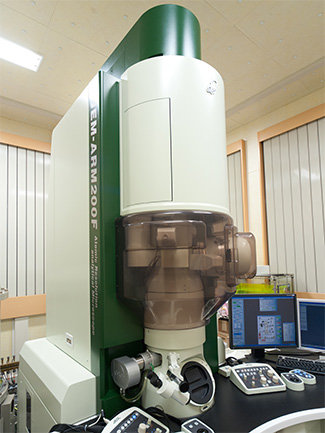
Scanning transmission electron microscopy is a method to observe fine structures of materials. STEM equipped with a spherical aberration corrector allows us to obtain high-angle annular dark-field images at a high resolution of 0.08 nm. It is also possible to analyze elemental distributions and chemical bonding states of materials by using energy dispersive X-ray spectroscopy and electron energy loss spectroscopy.
Focused Ion Beam system (FIB)
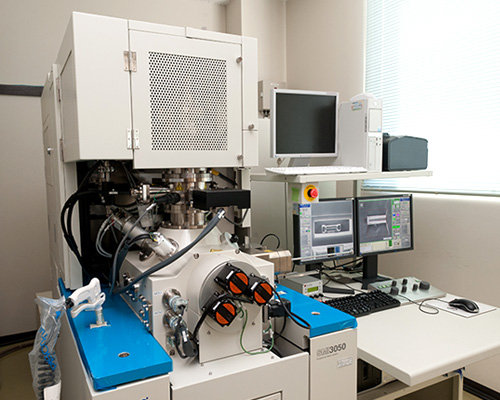
By detecting secondary electrons generated from the surface of a sample irradiated with a focused ion beam, it is possible to obtain the sample surface image called a scanning ion microscope (SIM) image. It is also possible to perform fine processing at a target position of the sample while observing the SIM image. The FIB system contributes to the preparation of samples for cross-sectional observations of transmission electron microscopy.
Equipment
| Molecular mass spectrometer (FT-ICR-MS) | Bruker, Germany: SolariX, scimaX |
| Drift-type ion-mobility MS | Waters, US: SYNAPT XS |
| Four-circle x-ray crystal analyzer | Rigaku Corporation: RASA-7A |
| Scanning electron microscope (SEM) | Hitachi: Regulus8230 |
| Transmission electron microscope (TEM) | Hitachi: H-7650 JEOL: JEM-ARM200F, JEM-2100Plus |
| Nuclear magnetic resonance spectrometer (NMR800MHz) | Bruker, Germany: AVANCE Ⅲ 800 |
| Solid-state nuclear magnetic resonance spectrometer (NMR 500MHz) |
Bruker, Germany: AVANCE III 500 |
| Nuclear magnetic resonance spectrometer (NMR 400MHz) | Bruker, Germany: AVANCE NEO 400 |
| Paramagnetic resonance spectrometer (ESR) | JEOL: JES-RE3X |
| X-ray photoelectron spectroscopy system (ESCA) | Fisons Instruments, USA: S-ProbeTM2803 |
| Focused ion beam system (FIB) | SII-NT: SMI3050 |
| Cluster formation reaction analysis system | Sumitomo Heavy Industries: SCI-400, SCR-500 JEOL: JSTM-4500VT |
| Maskless Aligner | Heidelberg Instruments, Germany MLA 150 |
* These are just some of the main pieces of equipment -there are many more.
